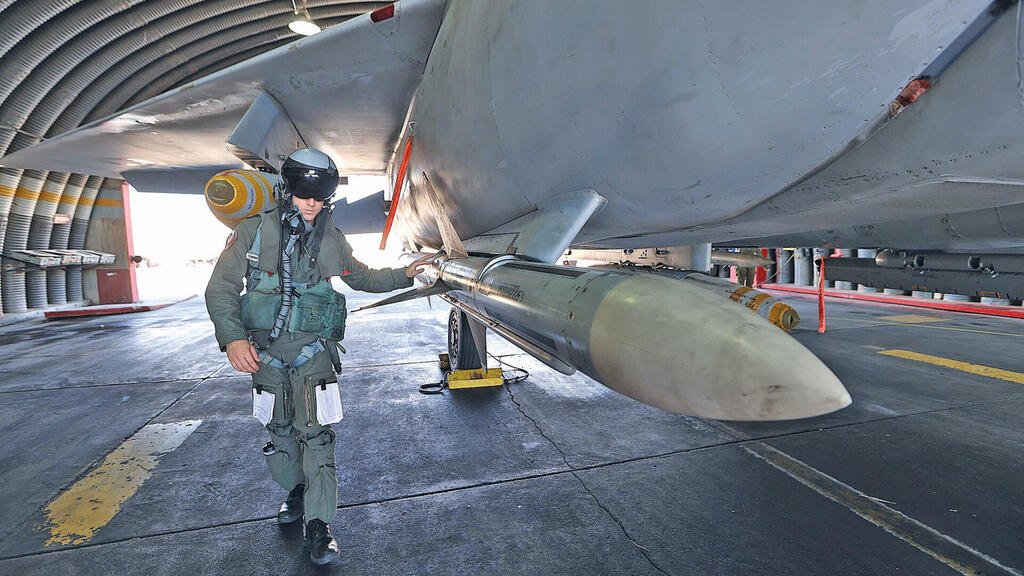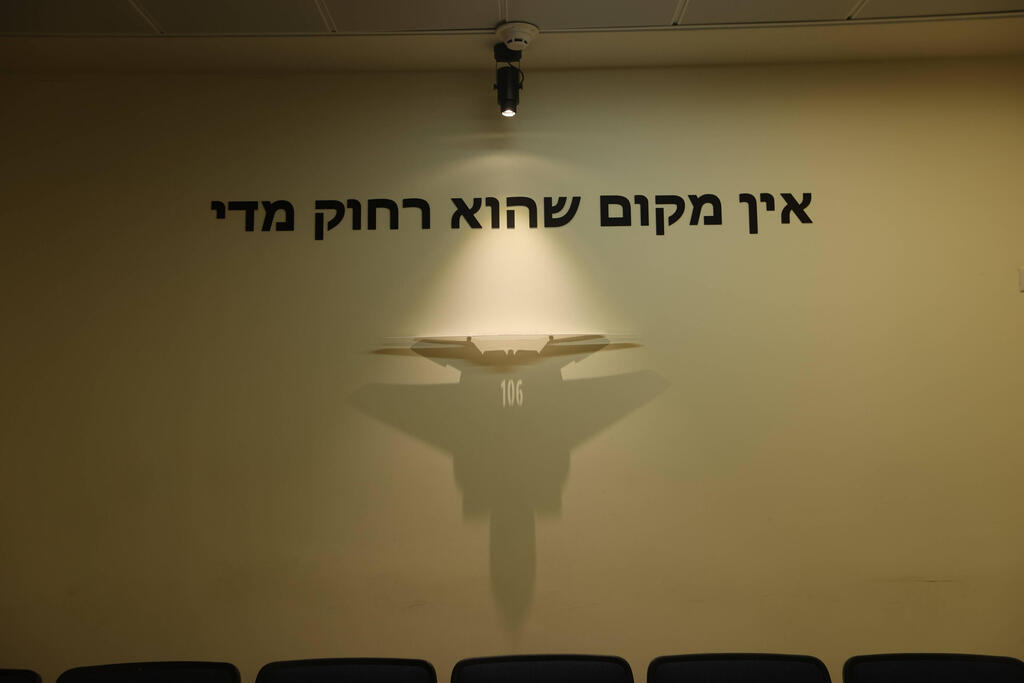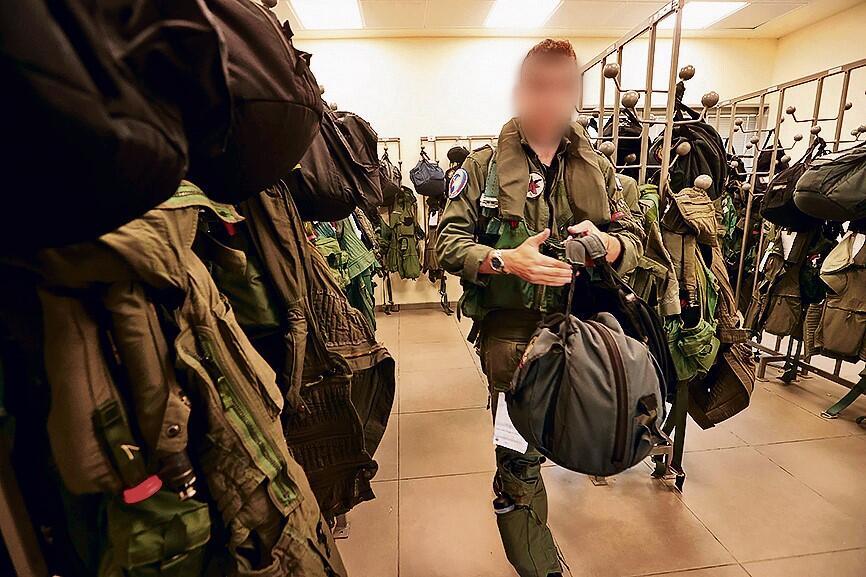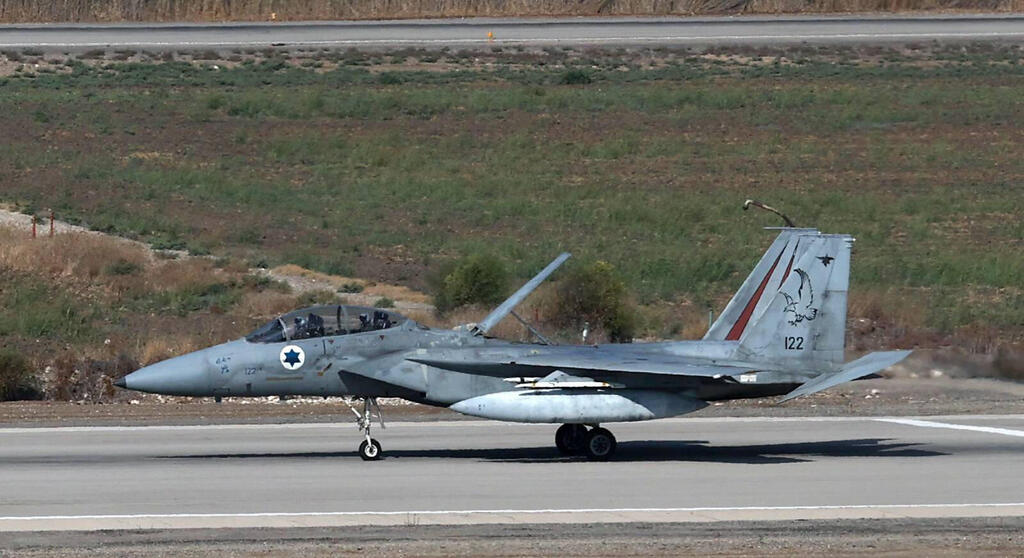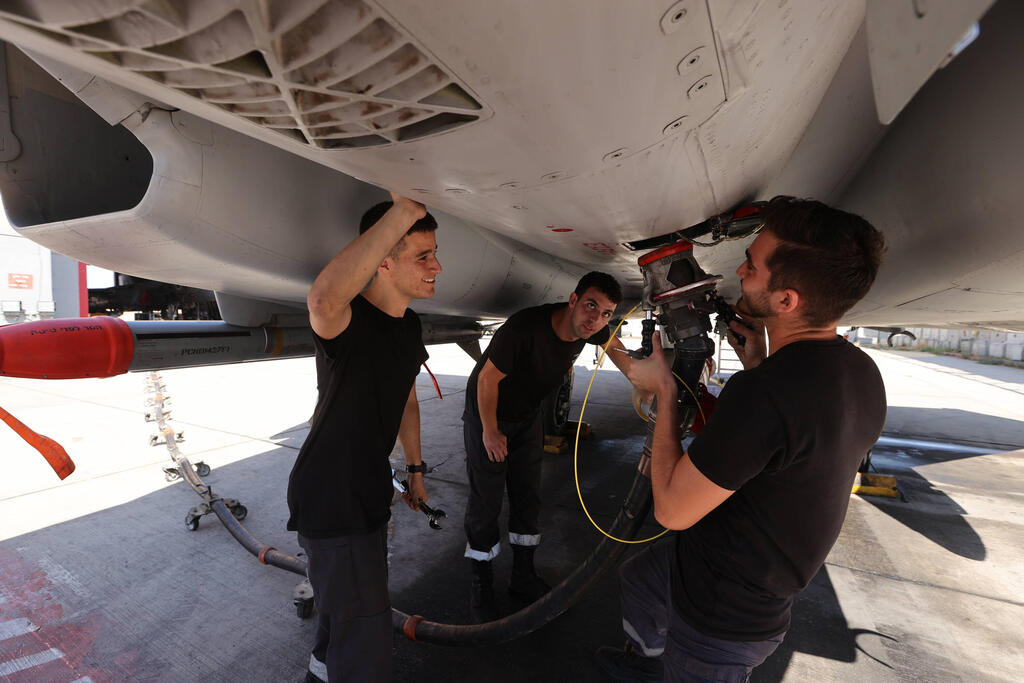The waiting is nerve-racking. Incidents along the northern border are becoming ever more frequent. Our enemies to the east are threatening us with missiles. To the south, maritime commercial traffic in the Red Sea to Eilat has been blocked. It’s clear to everyone that escalation is on the way.
Anyone who might feel they’ve been here before is no stripling. Try telling the youngsters about the anticipation of the summer of 1967, which ended with Israel dealing a crushing blow to the Arab armies in a war that went on for just six days. It sounds to them like an Arabian Nights tale. That's understandable when all they have known is a 300-day war that’s very far from ending anytime soon.
Israel is constantly revisiting its past. We’re at the Tel Nof IAF base that could well be a target for Iran and Hezbollah. We used to add mystery by saying it was "somewhere in central Israel" but now Waze can take you up to the main gate. Everyone serving at this huge base has been on high alert for the past week.
The wait in 1967 went on for two months. A month after the IAF shot down half a dozen Syrian MiG fighter jets over the Sea of Galilee in April 1967, Nasser closed the Red Sea on us. He'd advanced his troops deep into Sinai and Israel was panic-struck. Tel Aviv children dug trenches along Allenby Street by the Carmel Market. Teenagers in Ashkelon filled sandbags and piled them up in the neighbors’ yards. The wait for the great war that everyone feared was possibly harder than the war itself that broke out on June 5.
The waiting period ended with a surprise blow to the Arab armies and air forces. Mirage and Skyhawk fighter jets took off to attack Egyptian airfields from Tel Nof. But that’s all in the past. Today, the pilots sit and wait in the “villa,” which is a house that looks like the newer homes on a kibbutz or moshav. The yard is well kept with greenery and ornamental rocks, a wooden pergola over a deck balcony, and electric blinds shading the living room. This is where the aircrews are on standby.
There are three rooms with beds arranged like in a hotel, a fully equipped kitchen with soda and espresso machines, a huge TV screen, and a new Sony PlayStation. We found a deck of cards and a pile of gambling chips on the coffee table – evidence of a heated poker game while waiting for the long-expected attack.
As of Thursday, the war hasn’t yet broken out and fear is at an all-time high. Foreign airlines have suspended their flights to Israel and thousands of Israelis are stranded overseas, desperately searching for a spot on one of the Israeli airlines, who are exploiting the situation, charging exorbitant prices. The streets are empty, and people prefer staying at home with the children and having a safe room close by. You should have seen Tel Aviv earlier in the week. The city was almost as deserted as during the COVID lockdown.
But there’s a huge discrepancy between the fears and pressure conveyed on TV news programs and what happens in the 106th F15 squadron crew. Just two weeks ago, Hezbollah released a nine-minute aerial video of Ramat David airbase. The Shiite drone circled over the base, filming the squadron’s headquarters, aircraft hangers, runways, and even the commander’s office with great quality.
We can reasonably assume that all the IAF bases are targets for Hezbollah and Iran. When you have a threat and a state of vigilance, response time should be incredibly fast. This is why deputy squadron commander Maj. N. is walking around in a G-suit over his flight overalls. He has pipes coming out just beneath his waist, to be connected to an air pipe in the plane to avert pressure on the blood vessels at dizzyingly high speeds and altitude and maneuvering during flight. He has a cloth cap that he wears under his helmet dangling on his hip. He’s ready for immediate deployment and if a siren sounds at the squadron, he’s in the plane in minutes.
“But let’s not talk about us IAF crew,” says N. “The plane is ready for immediate takeoff. I just need to connect the parachute, and the plane can also land in the water and float if we need to eject. But right now, the plane’s looking good, fueled and armed. I just switch it on and take off. “
“I don’t want to talk about our level of vigilance. It changes according to intelligence and estimates. The transition from one level to the next is a matter of minutes. There’s a level where you’re in the air in minutes. There’s an immediate level that involves sitting in the cockpit with the engine turned off waiting for deployment. And then, the highest level where you’re in the cockpit with the engine on, and the plane ready for takeoff and you’re in the air in ten seconds. You’re looking at preparations for a war that may be just around the corner. I’m not walking around like this for nothing.“
The squadron holds two F15 models – a single seater, and a double seater. They’re not as new and sophisticated as the F35 but with a takeoff speed of 254 meters per second, and a maximum flight range of 3,459 km per second, this C model has nothing to be ashamed of. “This plane, by definition, is for interception. It’s what we call ‘air superiority’," says the deputy squadron commander. “But unfortunately, we have no one to fight in the air, at least not for now.”
He looks genuinely disappointed that there’s not a decent air force in the region. Perhaps reports this week of an Iranian order of state-of-the-art Sukhoi planes from the Russians signals the creation of a worthy competitor. “But it doesn’t mean we have no air-to-air missions before that. Look at the Iranian attack on April 14. The squadron has a good number of interceptions to its name on that night, both UAVs and cruise missiles.”
How many did you take down?
“I can’t say. I can only say that I was in one of the interception jets and it was a crazy scene. I was at 20 thousand feet, it was pitch dark and the sky was full of SSMs (Surface-to-Surface Missiles). I could see their fire trails. They have one heck of a rocket engine. I also saw fire trails of Arrow missiles fired at the SSMs, taking off at a crazy speed, and the interceptions above me. The challenge is locating the cruise missile moving toward us, an inclusive target as it travels at around 300 knots - the speed of a commercial plane. You need to make sure it’s the enemy.”
“And if you think that’s where it ends, you’ve no idea. It’s just the beginning. Once you’ve exposed it, you have to decide whether or not to take it down, whether to fire from close or long range, above or below, from in front of it or behind, and every such decision impacts armament and maneuvering and the angle toward the target - and I need to make all these decisions in a second, a second-and-a-half tops."
“And we took down a good number of UAVs and cruise missiles. It’s been four months since then, in which time we’ve been working non-stop. Last week, I was on a mission in South Lebanon. We took out a Hezbollah cell in one of the villages. Oh, and we also made it to Yemen. That alone was crazy.”
Speaking of Yemen, meet navigator Maj. R. His appearance is deceptive, like that of a mortgage bank clerk. But he’s an expert in driving “television missiles” directly to the target. “It’s nice that you want to talk about Yemen when we’re on full alert for an incident with Hezbollah in Lebanon and a possible attack from Iran or one of its proxies, or all of them together. Yes, I was in Yemen. Visibility was okay for half the way there. I saw the Straits of Tiran. But then, there was horrible haze and it ruins the whole sexy part of the story.”
The IDF is considering a possible attack on Iran, having attacked Yemen. N. explains that there’s no room for malfunctions during the flight. “Imagine you’re on a long flight to the United States, and just before reaching the ocean, there’s a malfunction in the plane. You veer 20° right and you can land at London’s Heathrow Airport. If you have a malfunction while you’re flying to attack Yemen, or some other target at a similar distance, where are you going to land? Sudan? Saudi Arabia?”
“And after flying for hours, you then have to bring yourself to a fantastic level of concentration to realize the reason you came all this way - taking the armaments and hitting them right on target. Flying all that way and then hitting next to the target, just isn’t good enough.”
“Think of ten seconds refining everything you’ve learned and practiced,” says navigator R. “This is your story as a combat soldier– these ten seconds. Making an alpha (hitting the target) at the first strike. In real life, we’re used to correcting ourselves, doing better next time, like shooting hoops, and if it’s no good, you rebound and try again. In an attack like this, like the one we carried out at Hudeidah Port in Yemen, there is no second time, no rebound. My pilot released a missile and I directed him there. You’re not dreaming at a time like this. You’re not hallucinating, you’re not thinking about anything. You’re 100% driving the missile to its target. You don’t let anything distract you.
How did you feel when you hit the target?
“Hell, I’m over Yemen and I now need to get back home’. Getting home is part of the mission.”
You don’t hear the drums of war here. We spent a few good hours at Tel Nof and we barely saw three F15s land. “Barely” as one of them did a quick flight over the base to make sure everything was in order, so that doesn’t really count. We climbed the control tower where we found female reservist Capt. N. who, in civilian life, is an air traffic controller at Ben Gurion Airport. She had two soldiers assisting her. N. was holding binoculars watching a plane approaching from the east for landing. “Watching to see that the plane’s wheels really pulled out when it’s ready to land is extra confirmation” she explained and, over the walkie-talkie, told the pilot “33 X left authorized to land.”
There was a ceramic vest lying on a chair in the control tower, a reminder of threats from outside. But N. refused to show us fear. “Our focus needs to be operating the airfield, taking off and landing planes, focusing only on that, not on threats and fears.”
Major B., the technical officer, also isn’t thinking about fears and threats. That’s what he has his wife for. She’s currently on maternity leave with two-month-old little Adam. “We live in the family barracks on base and my wife is very much aware of what’s going on. She has a bag packed and she needs 15 minutes to get out of here. That’s how long it takes her to fold up the stroller, get it along with the bag and the baby into the car, and push on the gas pedal. I trust our warning system to give enough time to prepare accordingly.”
We were sitting in an office in one of the hangers. Outside was a plane called “Ayelet Hashachar,” tail number 970, ready for battle, packed with bombs and missiles. “Look at it,” he says, nodding his head toward the plane. “What a wonderful machine. Look how the heavy hail sits on it.”
Heavy hail?
“JDAM (Joint Direct Attack Munition), a bomb weighing a ton. It has a fantastic carrying capacity. I can put on three detachable fuel canisters if it’s a long-distance mission. It can carry a great deal of ammunition for both attack and interception – bombs or missiles of all kinds. “Ayelet Hashachar,” for example, is armed with both missiles and heavy hail.
“I can tell you the vigilance here is at the highest level. This includes preparing the planes and the threats against us. Everyone here knows where the nearest safe room is. We all know that, even if they drop missiles here, planes will still have to take off and everyone knows how to conduct missions and prepare planes for attack under fire. There will be functional continuity, at a pace faster than now that we’re not under fire.”
“Planes are ready for takeoff within a very short time after landing – if there are no malfunctions. This means checking oil, refueling, rearming, putting air pressure in the tires, and running electrical voltage to test the cockpit systems. Whatever the mission: Gaza, Beirut, Iran, or Yemen, we run to every plane as if Judgement Day has come.”
There’s something about visiting a base like Tel Nof that gives the feeling that Israel isn’t yet completely lost. Three army bases have been broken into by rabble in the past two weeks. A few dozen Haredim broke into the Tel Hashomer recruitment offices. They were climbing the fences and the police weren’t there to stop them. Moreover, criminals broke into the Sde Teiman base, with right-wing MKs and a government minister egging them on. The mob then went on to break into the Biet Lid base.
The Air Force is our national security’s backbone. Our enemies have long known this. If a base or, God forbid, two are attacked, we would have a knife to our neck. I looked at how serious and professional those serving here at Tel Nof are, and couldn’t help but think this is the same army as at Beit Lid, Tel Nof, and Tel Hashomer. And if the mob broke in there, could it happen here too? Then you sit with technical officer B. from Netanya and N. the navigator from Efrat as they both proudly talked about what they do and their awe of the great responsibility placed upon them. N. glances at Ayelet Hashachar ready for take-off and casually says “It can be over Lebanon in minutes.”
They sit around in standby rooms, briefing and memorizing flight paths and flights to targets and the dangers awaiting them en route. “What we’ll encounter at every point,” says N. “It might be a shoulder-held missile or missile batteries. Not just in Lebanon – in Iran too and anywhere we might need to go. Look at this plane. It’s an amazing tractor with the most cutting-edge technology, totally state-of-the-art. It’s a beast that can carry bombs to every corner of the Middle East. We proved it a month ago in the attack in Yemen. Anyone who needed to understand, understood our capabilities. “
That smells a bit smug. Aren’t we being a bit too arrogant?
“We’re as modest as they come. Our enemies may strike us, but don’t worry about us. We’re ready. Whatever their attack looks like, we’ll be able to deal with it and address it. We’re the readiest we’ve ever been.”



